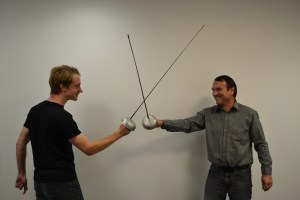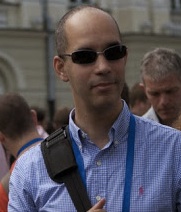The gravitational-wave observatory Advanced LIGO is now in its commissioning stage and preparing for its first scientific runs in early 2015. It will be soon followed by the Advanced Virgo detector. Being reasonably optimistic, one can expect the first detections to occur by 2018. The most likely sources to be observed are coalescences of two compact objects. As both detection and
parameter estimation rely on matched filtering techniques, several programs to compute accurate waveform models using various approximation techniques are being pursued. Notably, the post-Newtonian perturbative approach, where all quantities of interest are expanded in powers of Continue reading
Category Archives: IOPselect
Improved constraint on the primordial gravitational-wave density

Sophie Henrot-Versillé and Florent Robinet are research associates at the Laboratoire de l’Accélérateur Linéaire d’Orsay
Many cosmological models predict the existence of a stochastic Gravitational-Wave (GW) background produced just after the universe was born. As gravitational waves do not interact with matter, their detection would give us a unique and pristine probe to study the very first instants of the Universe: when it was 50 orders of magnitude younger than its age at the epoch of the photon decoupling. Such a detection would be as important as the discovery of the Cosmological Microwave Background (CMB). CMB studies tell us what the universe looked like when it became optically thin (~300,000 years after the Big Bang). They help us to establish the standard ΛCDM model of cosmology and to understand the important role of inflation. Continue reading
When coupling to matter matters

Claudia de Rham is an assistant professor at Case Western Reserve University working on cosmology and particle physics and is particularly interested in models of modified gravity and their embedding within consistent field theory frameworks.
How does matter couple in theories involving several metrics? We unveil the possibility for a new effective metric.
While the theory of general relativity will mark its 100 year anniversary next fall, the realization that the expansion of our universe may currently be accelerating has opened up the door for a series of investigations to understand the behavior of gravity at large distances – as large as the current observable Universe or about 1010 light years. Among the different possible modifications of gravity explored in the past decade, theories of gravity which involve several metrics have played a crucial role. The idea that gravity could be the outcome of several interacting metrics is of course not a new concept and such theories have been explored for more than 70 years, but their consistent realization has only been derived very recently in the past few years, and we are finally reaching a stage where we can understand more precisely how matter couples to gravity in such theories. Continue reading
A new algorithm for gravitational wave propagation

Casey Handmer (graduate student at Caltech) and Bela Szilagyi (senior research fellow at Caltech) discuss the finer points of null cone geometry.
Gravitational wave evolution – spectral style.
Colliding black holes create powerful ripples in spacetime. Of this we are certain. Directly detecting these ripples, or gravitational waves, is one of the hardest unsolved problems in physics. Inferring physical characteristics of black hole binaries and other gravitationally energetic events from their radiation requires accurate numerical simulation for matched filtering.
But gravitational wave simulations are typically plagued by a lack of gauge invariance. Waveform precision and validity is undermined by coordinate choice and movement. Simulations require an extraction methodology to obtain gauge invariant waveforms. These waveforms are Continue reading
Even a tiny cosmological constant casts a long shadow

Aruna Kesavan is a graduate student at the Pennsylvania State University
How safe is it to ignore the cosmological constant in the study of isolated systems and gravitational waves?
Analysis of isolated systems, such as stars, black holes and compact binaries, has dominated gravitational science, spanning diverse areas that include geometric analysis, computational relativity, gravitational waves, relativistic astrophysics and quantum black-holes. For example, over the past four decades, powerful positive energy theorems were proved, a theory of gravitational radiation in exact general relativity was developed, computational simulations were carried out to extract energy-momentum emitted during binary mergers, and evaporation of black holes was analyzed using appropriate Hilbert spaces of asymptotic states.
These advances are based on the Bondi-Penrose framework for zero cosmological constant . But by now observations have Continue reading
Non-CMC solutions to the Einstein constraint equations on asymptotically Euclidean manifolds with apparent horizon boundaries

Juan A. Valiente Kroon works on various aspects of mathematical Relativity and, in particular, on applications of conformal methods to analyse the global properties of spacetimes.
The construction of physically realistic data for the Einstein field equations is one of the great challenges of the Cauchy problem in General Relativity. In this paper C. Meier and M. Holst show how to construct solutions to the constraint equations of General Relativity representing data which will evolve, assuming that a certain form of weak cosmic censorship holds, into a spacetime containing one or more black holes.
The most studied procedure for solving the constraint equations is the so-called conformal method. This approach can be traced back to the pioneering work of Continue reading
Achieving resonance in the Advanced LIGO gravitational-wave interferometer

Alexa Staley is a PhD candidate at Columbia University in the City of New York, and has been working as a graduate student at the LIGO Hanford Observatory in Richland, WA.
The next generation gravitational wave interferometers, known as Advanced LIGO, located in Hanford, WA and Livingston, LA have been installed and are in the process of achieving a sensitivity required for the first direct detection of a gravitational wave. The goal of their design is to measure a gravitational strain as small as 4×10–24/√Hz, requiring a length resolution of approximately 10–19 rms within a 100 Hz bandwidth. This high sensitivity demands multiple optical cavities to enhance the response Continue reading
Black holes against the universe – particle and photon orbits in McVittie spacetimes

Brien Nolan is a Senior Lecturer in the School of Mathematical Sciences, Dublin City University
Black holes have a potential technological application that is frequently overlooked: they allow you to look at the back of your own head. This could be useful for checking that your tie is properly tucked into your shirt collar, or – perhaps more relevant for physicists – that your pony tail is straight. This technology relies on the fact that there exist circular photon orbits in all members of the Kerr-Newman-de Sitter family of spacetimes for which the parameters (mass, charge and cosmological constant) correspond to a black hole.
The question arises as to whether this characteristic feature of electro-vac Continue reading
Holographic entanglement obeys strong subadditivity

Aron Wall is a member of the School of Natural Sciences at the Institute for Advanced Study. In his spare time he blogs at Undivided Looking. He was the 2013 recipient of the Bergmann-Wheeler thesis prize, which is sponsored by Classical and Quantum Gravity.
Gauge-gravity duality allows us to calculate properties of certain quantum field theories (QFT) from classical general relativity. One famous piece of this conjecture, due to Ryu and Takayanagi, relates the entanglement entropy in a QFT region to the area of a surface in the gravitational theory. In addition to being a clue about quantum gravity, this proposal is one of the few tools which allow us to calculate entanglement entropy analytically. Since the entanglement entropy is of increasing interest for field theory and condensed matter applications, it is important to check if the conjecture is true.
One important property of the entropy is strong subadditivity (SSA). This quantum inequality says that the sum of the entropies in two regions is always greater than the sum of the entropies of their union and intersection. My article uses proof Continue reading
Black holes as beads on cosmic strings

Amjad Ashoorioon (left) is a Senior Research Associate at the physics department of Lancaster University in the United Kingdom. Robert B. Mann (right) is a Professor of Physics and Applied Mathematics at the University of Waterloo, Ontario, Canada.
Cosmic strings have been a source of fascination in cosmology since Tom Kibble first proposed their existence 40 years ago. Like an imperfection in a solidifying crystal, a cosmic string is a thread of energy that might have formed in the early universe during a symmetry breaking phase transition. Twenty years ago Ruth Gregory pointed out that a black hole could have a cosmic string as a single “hair”. Turning this idea around, in this article we have proposed that a Continue reading


You must be logged in to post a comment.